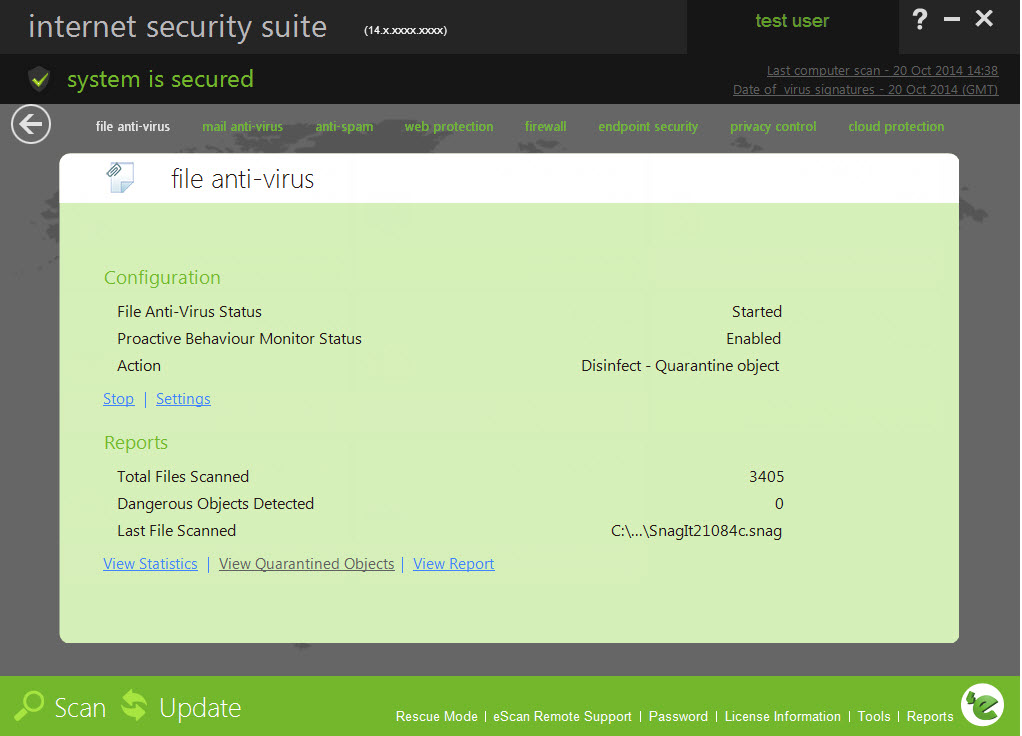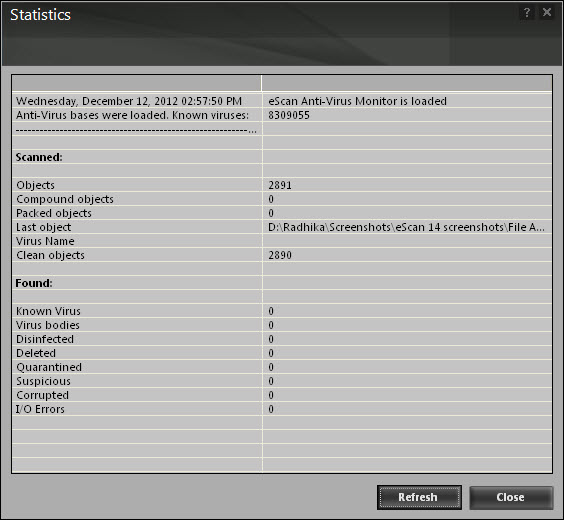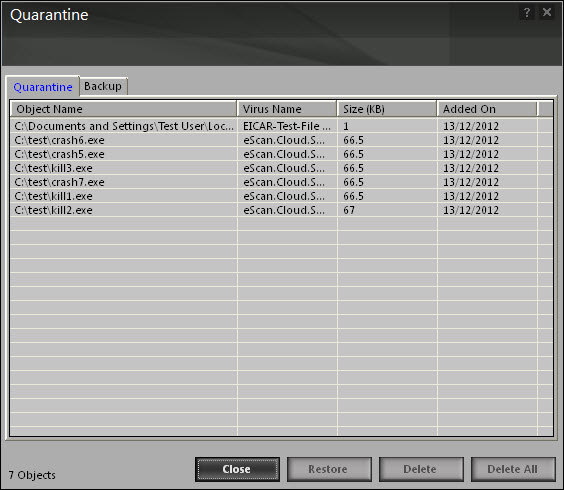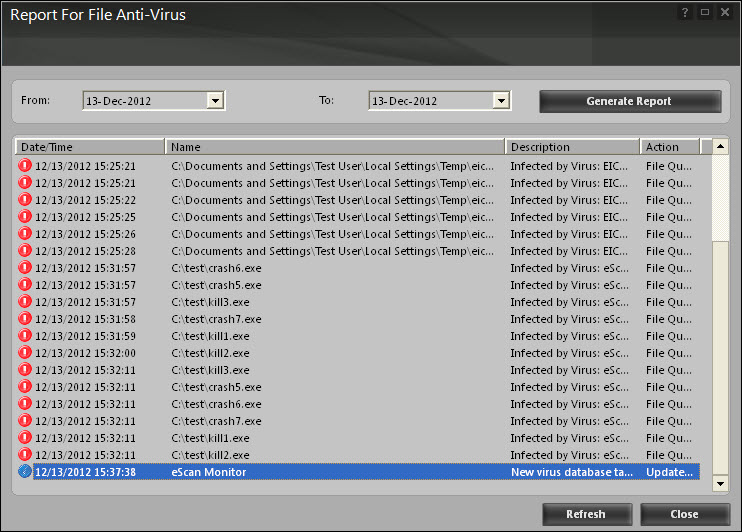From eScan Wiki
Revision as of 06:09, 9 January 2013
eScan Version 14 Online Help
Web Protection
This section provides the description of eScan's Web Protection and the various settings available in this feature.
Contents |
Description
Web Protection is the fourth module of the eScan for ISS. This module uses highly advanced algorithms based on the occurrence of specific words or phrases in the contents of web site and to block Web sites containing pornographic or offensive material. This feature is extremely beneficial to parents because it prevents kids from accessing Web sites containing harmful or restricted content. Administrators can also use this feature to prevent employees from accessing non-work-related web sites during work hours.
This page provides you with options required to configure the module. You can configure the settings from the following 2 sections:
Configuration
This section displays the following information.
- Web Protection Status : It displays the status of whether Web Protection module is started or stopped.
- Selected User Profile : It displays the selected user profile with its status.
- Web Phishing Filter Status : It displays the status of Web phishing filter.
Start/Stop:
Click an appropriate option to enable or disable Web-Protection module.
- Note: If you want to apply the web protection settings to the selected user profile, You have to make sure that web protection status is enabled on both the windows – on the eScan main window, under Configuration section, Start/Stop option and on the Web Protection Settings window, enable/Disable button on upper-left corner of the window.
Start/Stop Phishing Filter: Click this button to start and stop the phishing filter.
Settings: When you click this button, the Web Protection Settings window appears. On the Web Protection Settings window, you have four different profiles – Walled Garden, Teenager, Adolescent, and Adult. You can change the web protection status of the selected user profile and you can edit the settings of the selected profile.
- Note: On below the screen of all the tabs contains four buttons — Default, OK, Cancel, and Apply, which you have to use after configuring the settings based on your requirement.
- - Default: Click this button to apply the default settings.
- - OK: Click this button after you click the Apply button to apply the configured settings.
- - Cancel: Click this button to cancel the configured settings or to close the window.
- - Apply: Click this button to apply the configured settings.
- Note: On below the screen of all the tabs contains four buttons — Default, OK, Cancel, and Apply, which you have to use after configuring the settings based on your requirement.
Perform the following steps to edit the settings of a profile:
- Click the Settings button.
- Select an appropriate profile for which you want to change the settings from the Select Profile drop-down list, and if you want to change the web protection status of a profile, click Enable/Disable button on upper-left corner of the window, and then click the Edit Profile button. The Web Protection (Adult) window appears.
- Click the Filtering Options tab.
- Filtering Options
- Scanning Options
- Options
- Block Files
- Folder Protection
- - The current details of the system date, time, and whether the eScan Anti Virus monitor is running or not.
- - The number of viruses detected.
- - The results of most recent scan, such as the last object scanned and name of the virus detected.
- - Quarantine: This tab displays the files that have been quarantined. You can restore or delete the quarantined objects by right-clicking the object, and then clicking an appropriate option.
- - Backup: This tab displays the files that were backed up by File Anti Virus before it tried to disinfect them. You can restore or delete the objects that were backed up by right-clicking the object, and then clicking an appropriate option. Before clicking any of these buttons, you should ensure that you have selected an appropriate row in the table for which you need to perform the action.
The Web Protection Settings window appears.
The Web Protection (Adult) window appears.
This section provides you with options for filtering the websites based on various categories. You can either allow or block websites depending on certain words/phrases that are found in the web sites.
- Status: This section helps you to allow or block access to specific Web site based on Filter Categories. You can set the status as Active or Block Web Access. Select the Block Web Access option, if you want to block all the web sites except the ones that have been listed in the Filter Categories. When you select this option, only Filtering Optionsand Pop-up Filter tabs are available.
--> Filter Categories: This section uses the following color codes for allowed and blocked Web sites.
>> Green: It represents an allowed Web site.
>> Red: It represents a blocked Web site.
The filter categories used in this section include Pornography, Gambling, Chat, Alcohol, Violence, Drugs, Ratings_block_category, Websites_Allowed, and so on. You can also add or delete filter categories depending on your requirement.
--> Category: [Category name]: This section shows the Words / Phrases list, which lists the words or phrases present in the selected category. In addition, the section displays the Site Names list, which lists the Web sites belonging to the selected category. You can also add or delete filter categories depending on your requirement.
--> Filter Options: This section includes the Add sites rejected by the filter to Block category check box. Select this check box if you want eScan to add Web sites that are denied access to the Block category database automatically.
This tab helps to block images, ActiveX controls, media components, and applications from appearing within the browser.
- Scan local removable disk drives: [Default] Select this check box if you want the real time monitor to scan all the local removable drives attached to the computer.
- Scan local hard disk drives: [Default] Select this check box if you want the real time monitor to scan all the local hard drives installed on the computer.
- Scan network drives: [Default] Select this check box if you want the real time monitor to scan all the network drives including mapped folders and drives that are connected to the computer.
- Scan files of following types: It indicates the type of file that you want the real time monitor to scan. You have 3 options where you can select files for scanning, whether all infectable, all files, or by mask. The files listed in By mask option are the default file extensions that are defined by eScan. To add or delete files by mask, double-click Add/Delete option, and then add or delete files as required.
- Exclude by mask: [Default] Select this check box if you want the File Anti Virus monitor to exclude all the objects in the Exclude by mask list during real time monitoring or scanning. You can add or delete a file or a particular file extension by double-clicking the Add / Delete option.
- Not a Virus List: [Default] File Anti Virus is capable of detecting riskware. Riskware refers to a software that is originally not intended to be malicious, but somehow can pose as a security risk to critical operating system functions. You can add the names of riskware, such as remote admin software to the riskware list in the Not a virus list dialog box by double-clicking the Add / Delete option, if you are certain that they are not malicious. The riskware list is empty by default.
- Exclude Files/Folders: [Default] Select this check box if you want File Anti Virus to exclude all the listed files, folders, and sub folders, while it is monitoring or scanning folders. You can add or delete folders from the existing list of folders by double-clicking the Add / Delete option.
- Scan compound objects: [Default] Select this check box if you want eScan to scan archives and packed files during scan operations. Select Archive check box, if you want eScan to scan archive files. You can define the depth level of an archived file upto which you want to scan. By default, value is 16, but you can change it by double-clicking the icon, and then type value in the size box. By default, Packed is selected.
- Enable code analyser: Select this check box if you want the real time monitor to scan your computer for suspicious objects or unknown infections by using the heuristic analyzer. When this check box is selected, File Anti Virus not only scans and detects infected objects by using the definitions or updates, but it also checks for suspicious files stored on your computer.
This tab helps you configure the basic settings for the File Anti Virus module, such as the maximum size of log files and path of the destination folder for storing log files, quarantined objects, and report files.
You can configure the following settings:
- Save report file: [Default] Select this check box if you want eScan to save the reports generated by the File Anti-Virus module. The report file logs information about the scanned files and the action taken by File Anti Virus when an infected file was found during the scan.
--> Show pack info in the report (Monvir.log): [Default] Select this check box if you want File Anti-Virus to add information regarding scanned compressed files, such as .ZIP and .RAR files to the Monvir.log file.
--> Show clean object info in the report (Monvir.log): Select this check box if you want File Anti-Virus to add information regarding uninfected files found during a scan operation to the Monvir.log file. You can select this option to find out which files are not infected.
--> Limit size to (KB) (avpM.rpt): Select this check box if you want File Anti-Virus to limit the size of the avpM.rpt file. You can double-click the size box and specify the size of the log file. The default value is 50 KB
- For quarantining of infected objects: This option helps you specify the destination for storing quarantined objects. By default, the quarantined objects are stored in the C:\Program Files\eScan\Infected folder. You can change the location of the destination folder if required.
- Enable Auto backup / Restore: [Default] Select this check box if you want eScan to take automatic backup of critical files of the Windows® operating system installed on your computer and to restore the clean files when it finds an infection in any of the system files, which cannot be disinfected. You can do the following settings:
--> For backup of clean objects: You can back up uninfected objects and store them in a given folder. By default, these objects are stored in the E:\FBackup folder. You can change the destination of the backed up objects if necessary.
--> Do not backup files above size (KB): [Default] This option helps you prevent File Anti Virus from creating backup of files that are larger than the file size that you have specified. The default value is set to 32768 KB
--> Minimum disk space (MB): [Default] It enables you to set the minimum free hard disk space upto which you want eScan to take backup of files. By default, value is 500 KB, but you can change it by double-clicking the icon, and then type value in the size box.
- Limit file size to (KB): [Default] This check box enables you to set a size limit for the objects or files to be scanned. The default value is set to 20480 KB.
- Use sound effects for the following events: This check box helps you configure eScan to play a sound file and show you the details regarding the infection within a message box when any malicious software is detected by File Anti Virus. However, you need to ensure that the computer speakers are switched on.
- Display attention messages: [Default] When this option is selected, eScan displays an alert, which displays the path and name of the infected object and the action taken by the File Anti Virus module.
- Enable Malware URL Filter: Select this check box, if you want to block access to malicious websites/URL’s.
- Proactive Behaviour Monitor: Select this check box, if you want eScan to monitor the executable files you are running on your system.
In case, if eScan finds any executable files suspicious or may cause any harm to your system, it pops-up with a message. If you want to access the suspicious file, you can white list them anytime.
This tab helps you configure settings for preventing executables and files, such as autorun.inf, on network drives, USB drives, and fixed drives from accessing your computer.
You can configure the following settings:
- Deny access of executable from Network: Select this check box if you want to prevent executables on your computer from being accessed from the network.
- Deny access of executables on USB Drives: Select this check box if you want to prevent executables stored on USB drives from being accessed.
- Deny access of AUTORUN.INF on USB and Fixed Drives: [Default] Select this check box if you want to prevent executables from USB and fixed drives from being accessed.
- Deny Access of following files: [Default] Select this check box if you want to prevent the files in the list from running on your computer.
- Quarantine Access-denied files: Select this check box if you want to quarantine files that have been denied access.
You can prevent specific files from running on your computer by adding them to the Block Files list. By default, this list contains the value %sysdir%\*.EXE@.
This tab helps you protect specific folders from being modified or deleted by adding them to the Folder Protection list.
It allows you to configure the following setting:
- Protect files in following folders from modification and deletion: [Default] This option is selected by default. Select this check box if you want the File Anti-Virus module to protect files in specific folders from being modified or deleted.
Reports
This section displays the following information.
- Total Files Scanned: It shows the total number of files scanned by the real-time File Anti Virus monitor.
- Dangerous Objects Detected: It shows the total number of viruses or malicious software detected by the File Anti Virus monitor on a real-time basis.
- Last File Scanned: It shows the name of last file scanned by File Anti Virus monitor on real-time basis. In addition, you can view the following reports:
View Statistics:
When you click this button, the Statistics dialog box is displayed, which displays the latest activity report of the real-time monitor. The report contains information under two sections — Scanned and Found, under Scanned, the number of scanned objects, compound objects, packed objects, clean objects, and so on are displayed, and under Found, the number of known virus, virus bodies, deleted, quarantined, and so on are displayed.
In addition, it displays the following information:
View Quarantined Objects:
When you click this button, the Quarantine dialog box is displayed, which displays the quarantined files and backup files. This dialog box has the following tabs.
View Report:
When you click this button, the Report for File Anti Virus window is displayed. This window displays the report for the File Anti Virus module for a given range of dates in a tabular format when you click the Generate Report button.









